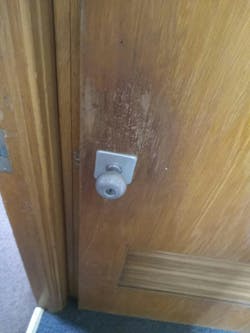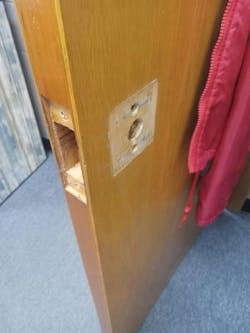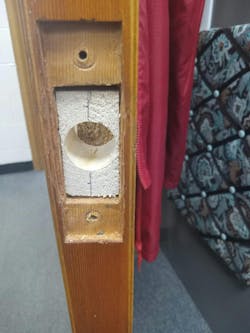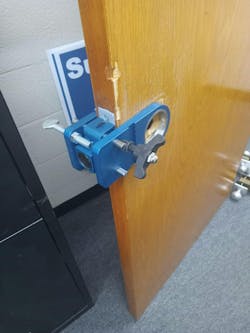Winning this school security job, which involved replacing classroom door locks with LSDA 5000 leversets, was step one. Now it’s time to accomplish what the customer wants with the actual installation.
The customer wanted to keep the “master,” so I needed more information on the school’s keying system. The superintendent presented me with the current ‘master key’ and said she didn't know of any ‘regular’ keys. My first thought was either to expand the system or generate a new master key system and change the ‘master’ into a change key.
To expand the system, I needed to understand the existing system, so I tried to reach out to the locksmith on the key. That company had closed down many years ago, so this made the next step more ‘smithy.’
Without documentation on the original system, I would have to decode the system by choosing from some random cores throughout the school. While this method will directly give me the information needed, it has a flaw: worn-down pins. Corbin Russwin systems use similar depths across various systems, the DH pre-70 System is a two-step 10-depth system and the 70 system is a single step with 6 depths. I won’t go into the specifics of Corbin Russwin pinning in this writing today, but I will say several of the pins I measured did not match either DH system.
Regaining Key Control
To decide between expansion or replacement of the key system, I asked one simple question, “Do you want every teacher here to have access to your office?” From this I knew which option to choose.
Over the years, the school has had an interesting assortment of keys. The master was Corbin Russwin; most of the classrooms had Sargent keys; and several offices had Kwikset locks. There was one Medeco Bi-axial double-sided deadbolt on a classroom and no one had that key.
One advantage of this project is simplifying this key craziness; the other is proper access control.
I must point out that there is a cross key issue and security issue with this approach. When keeping the original master in the system, anyone who previously left without returning their key will still have access, albeit more limited now, and the cross key or ghost keys that can occur can be mitigated. But be sure there is clear conversation, and the customer knows, this is a lower security risk issue.
After decoding pins and speaking with ASSA ABLOY Key Systems, I had a new master. After a few key meetings where it was decided which staff would have access to which door, a new key schedule was born.
Installation Begins
There are two ways to do an install: quick and professional. That is not to say that a professional job is slow, but it does require deliberate, planned movements. For this, I look toward my Operational Risk Management training questions: What can go wrong? What can I do to prevent it from going wrong? If I can’t prevent it from going wrong, who do I call?
There are two methods of converting from a mortise edge conversion and full door wraps. The issues with full door wraps are bevel and fit. I cannot count the number of times I have come up to a door with a wrap that “won’t close right” because the wrap was just slapped on. A proper installation of a door wrap, at least on a wood door, should be cut into the edge of the door so the latch is properly flush with the door edge and aligned with the proper bevel. That 1/8” steel will throw off a door when not installed right.
The other option is to use an edge filler. This solves the two issues above. By filling the hole on the edge of the door, the latch stays properly spaced and doesn’t interfere with the door bevel. As the Sargent lock footprint was contained to the knob area, and there was no massive damage anywhere else on the door, the edge conversion made the most sense. Don-Jo Manufacturing makes an edge filler exactly for this conversion. The CV-2414 helped make this a clean install.
Now, the next issue which is common when converting from mortise to cylindrical locks is that the side loading of the latch can allow the latch to ‘walk out’ of the cylindrical jaw. For this I looked at some commercially available latch guides, but I couldn’t find the exact product I needed. So after conversations with a few other smiths, I decided if I can’t buy what I need, I can build what I need.
With a few measurements of the new cylindrical latch and lock body, I fashioned door supports from 2x4s that I had around the shop. These fillers would: 1. hold the latch in place and 2. fill most of the hole left in the door from the conversion which can restore some strength to the door. By using wood blocks, they can be mechanically held by the latch screws through the Don-Jo plate, and on several, I additionally chemically bonded them with JB Weld for wood. (Photos 4 and 5)
The Framon Bulls Eye Drill Rig, designed from the A-1 plans (Photo 7), made drilling these doors very quick and very clean, using a 1” hole saw placed between the latch on the rig and plate, aligned the jig fast, then just a quick 2-1/8 on both sides and a 1/8 top and bottom, especially when doing many doors.
Doing a professional install, which includes keeping a work area clean, the GKL Door Caddy (Photo 9) was a big help. Not only did I keep the drillings caught, but it also provided a nice space to keep drill bits, hole saws, and screwdrivers in easy reach during installation. The finished look even covers up the edges of the squares of the Integra’s rose (Photo 8).
Nicholas Rice owns Nick’s Lock and Security, serving Battle Creek, Marshall and Coldwater in southwest Michigan.





